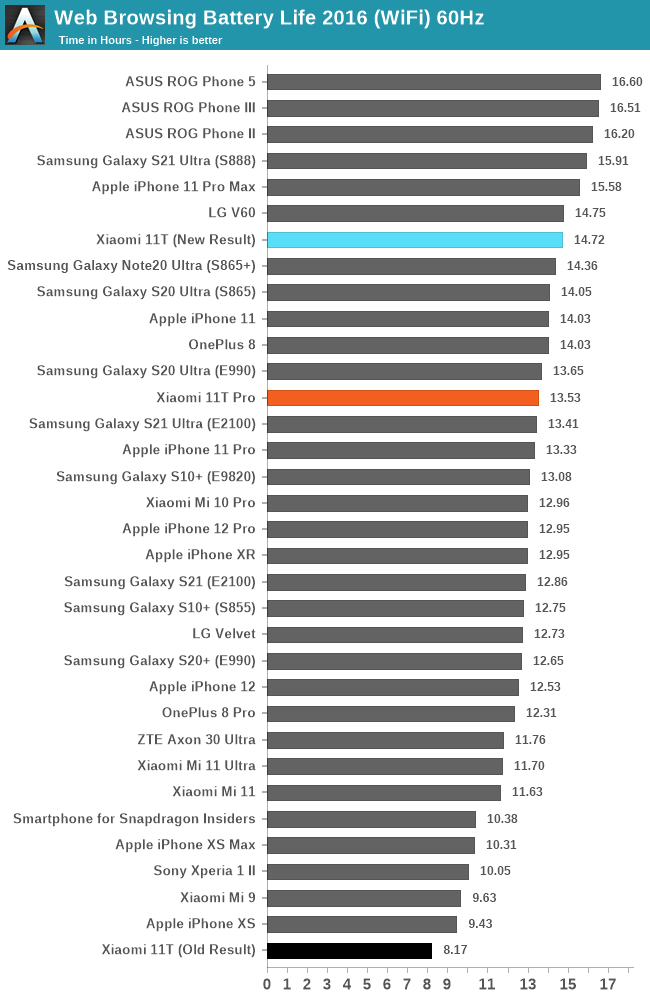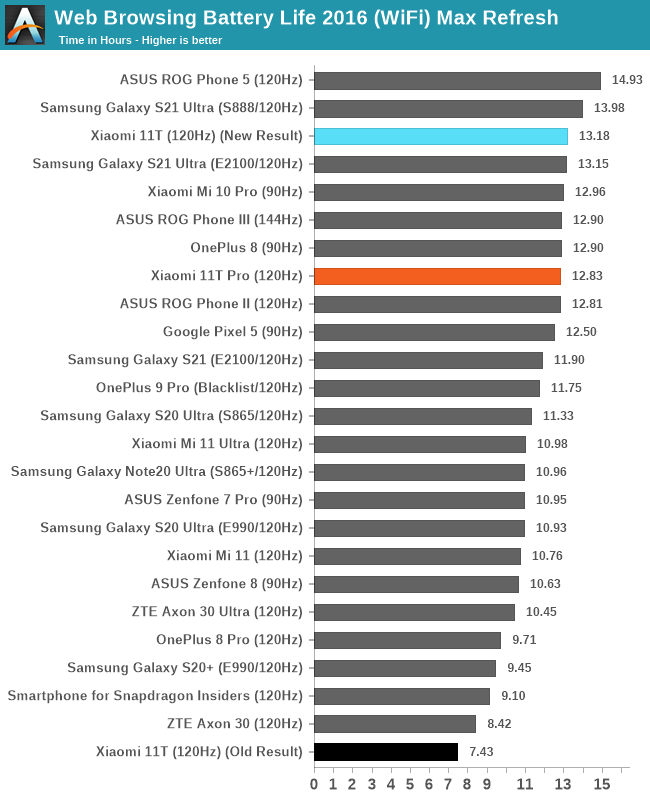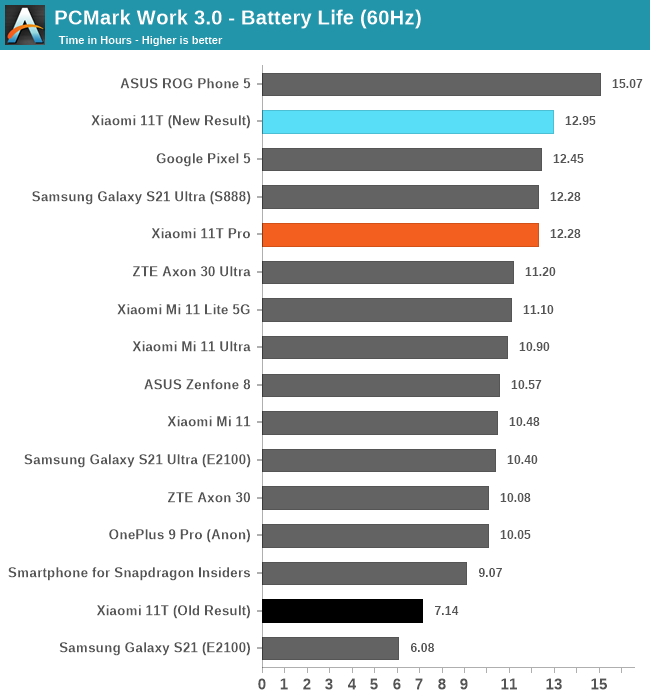The Xiaomi 11T & 11T Pro Review: Two Chips, With a Battery Focus
by Andrei Frumusanu on September 15, 2021 9:00 AM EST- Posted in
- Mobile
- Smartphones
- Xiaomi
- Xiaomi 11T
- Xiaomi 11T Pro
Battery Life
Battery comparisons between the 11T and the 11T Pro are again very interesting given the fact that we have to identical devices, only differing between each other in terms of SoC employed.
As noted in the earlier sections, there are a few differences in CPU behaviour, particularly the 11T Pro really not using the Cortex-X1 cores of the Snapdragon 888 too much. However, the 2.41GHz A78’s of the Snapdragon 888 are only 5% slower than the 3GHz A78 of the Dimensity 1200 – due to Qualcomm’s larger CPU and system caches, and better memory latency. So in terms of performance, as we noted before, the Snapdragon 888 11T Pro should still exceed that of the 11T, so it’ll be still somewhat valid comparison even without the X1 cores.


Update September 17th: Our 11T sample received a software update the day of the review embargo – we retested our initial battery life results and have seen significant improvements over the initial review firmware. We’re in the process of redoing all the battery life tests and will update the review to reflect the updated experience.
In the web browsing tests, the results couldn’t be more different, and the discrepancy between both phones frankly shocked me.
The 11T with the MediaTek SoC only managed to get 57-60% of the battery life of the Snapdragon 11T Pro. Again, I have to emphasise that these two devices are otherwise identical – same battery capacity, and same screen, and I haven’t been able to measure any difference in power between the two phones at the same screen brightness. What this means, is that the delta here seems to be related to the SoC.


In PCMark as well, the 11T is only showcasing 58-61% of the longevity of the 11T Pro, all whilst showcasing worse performance numbers.
The results for the 11T both in the web test and in PCMark are just abysmal. I did run power analysis on all the CPUs in SPEC, and yes, the Snapdragon 888 is quite a lot more energy efficient than the Dimensity 1200, however not to a degree to actually end up with such a large battery life discrepancy – at least not that I would assume.
The 11T was noticeably warmer than the 11T Pro in the battery tests, which is kind of obvious given that it evidently uses more power. For me, the MediaTek powered 11T is dead in the water, as the results here are just too bad.
The 11T Pro’s battery life was good, and what surprised me the most is that it’s the only non-Samsung Snapdragon 888 phone that didn’t exhibit terrible baseline power consumption. I’m not sure what to attribute this to, but it ends up with quite good results, though still lagging behind the S21 Ultra with its much more efficient display.
Update September 17th: Our 11T sample received a software update the day of the review embargo – we retested our initial battery life results and have seen significant improvements over the initial review firmware. We’re in the process of redoing all the battery life tests and will update the review to reflect the updated experience.
Update September 22nd: The new battery tests have been completed and updated. The 11T with the MediaTek SoC now represents the expected battery life results out of the chip, showcasing slightly longer battery life compared to the Snapdragon 11T Pro. In terms of absolute results, they’re very good compared to other comparative 120Hz powered devices, and both 11T and the 11T Pro showcase excellent longevity.










41 Comments
View All Comments
arayoflight - Wednesday, September 15, 2021 - link
The battery life test of D1200 phone is rather surprising. The OnePlus Nord 2 which uses the same chipset does pretty well in GSMArena's battery test: https://fdn.gsmarena.com/imgroot/reviews/21/oneplu...yeeeeman - Wednesday, September 15, 2021 - link
Yep, I suspect this is a xiaomi thing, not something really bad with the soc, as I would expect mediatek engineer to be able to test power consumption of their soc before releasing it to the market.flipp0 - Thursday, September 16, 2021 - link
Yes, I had the Nord 2 and battery life was great. I think it is likley that anandtech got a faulty 11T unit or that 11T has some kind of software bug draining the battery. I am suprised that Andrei does not mention this a possible explanation for the results reported in this review.Spunjji - Monday, September 20, 2021 - link
Crappy software. Glad to see they fixed it, but that was pretty poor to be releasing a review unit in such a bad state.eastcoast_pete - Wednesday, September 15, 2021 - link
Thanks for the test, especially taking a close look at power management of the SoCs! I guess the overheating issue with the 888 indicates both the appetite of the X1 for power, and the need for good thermal design when used in a close, confined space like a Smartphone. Almost looks as if Xiaomi assumed that designs for older, lower powered SoCs would work just fine with the 888, and was in for a nasty surprise when it didn't.It's too bad that Xiaomi seems to then insist on "improving" these phones with their idea of enhancement by software, which clearly doesn't work. Those results for the Dimensity are also surprising, and not in a good way.
The temperatures measured remind me of an old phone with the SD 808 many years ago; probably the worst SoC QC I ever had the displeasure of owning.
shabby - Wednesday, September 15, 2021 - link
Interesting to see the price difference when the only difference is the soc, Qualcomm sure charges a premium.shabby - Wednesday, September 15, 2021 - link
But ouch that battery life, shirley some software updates might fix this?Spunjji - Monday, September 20, 2021 - link
And they did!PEJUman - Wednesday, September 15, 2021 - link
Curious if Xiaomi is using 'power' cells instead of 'energy' cells on their phones. Or if they are simply pushing energy cells with obscene C rates (at 4V * 4Ah, that's a mere 16 Wh of energy capacity), charging this at 100+ Watts to full is basically 6+ C charging rates.Either they have great battery tech, not sure who is their supplier for these... or the customer will just have to contend with rapid aging of their battery as they fast charge it everyday.
DanNeely - Wednesday, September 15, 2021 - link
Killing batteries early goes right with making battery replacement difficult as a means to drive more sales of new phones.